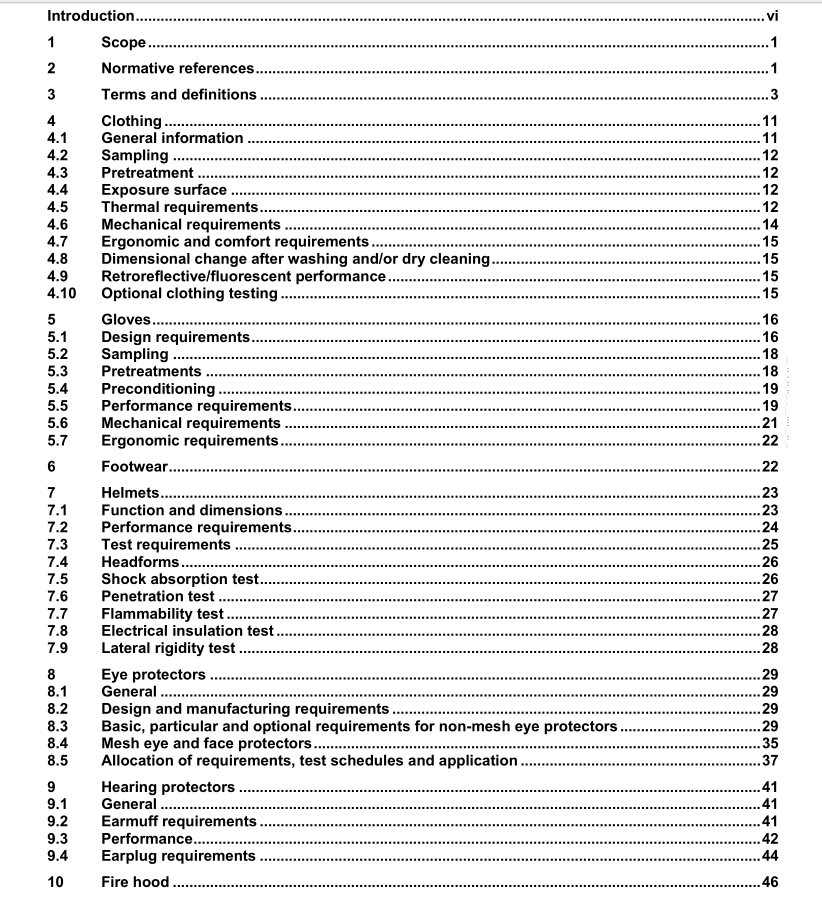ISO 16073 pdf download

ISO 16073 pdf download Wildland firefighting personal protective equipment — Requirements and test methods
4.6.3 Main seam strength
Main seams in the outer garment,when tested in accordance with ISO 13935-2, shall give a seam strength≥ 300 N.
4.7Ergonomic and comfort requirements4.7.1General
Testing shall be done in accordance with 4.7.2 and 4.7.3 or, alternatively,4.7.4.
4.7.2Thermal resistance
When tested in accordance with lSO 11092,the material or material combination shall give a thermalresistance ≤ 0,055 m2 K/W.
4.7.3 Water vapour resistance
When tested in accordance with ISO 11092, the material or material combination shall give a water vapourresistance ≤ 10 m2 Pa/w.
4.7.4Total heat loss
When tested in accordance with Part C of ASTMF 1868-02, the material or material combination shall give atotal heat loss requirement ofa 540 wim2.
4.8Dimensional change after washing and/or dry cleaningDimensional changes shall be measured in accordance with ISO 5077.
Garments labelled for washing only: five cleaning cycles shall be carried out in accordance with IS0 6330,washing procedure 2A, each with a drying cycle according to procedure E.
Garments labelled as dry cleanable: five dry cleaning cycles shall be carried out in accordance withlSO3175-1.
Dimensional change shall not exceed 3 % in both the machine and cross direction.4.9Retroreflective/fluorescent performance
Photometric requirements of the retroreflective/fluorescent combined performance material shall bedetermined in accordance with test method CIE 54.2. The minimum coefficient for new retroreflectivelfluorescent combined performance material shall be in accordance with EN 471:2003,Table 4 or6.
The reflectivity after testing in accordance with EN 471:2003, Table 7, shall be greater than or equal to thevalue in EN 471:2003,6.2.2,6.2.3 or 6.2.4, with the observing angle at 12 min and the entrance angle at 5°.
4.10 Optional clothing testing
The complete clothing assembly intended for use to provide protection in accordance with the requirements ofthis International Standard shall be tested in accordance with ISO 13506,using a heat flux of 84 kW/m2 andan exposure time of 4 s.
5 Gloves
5.1 Design requirements
5.1.1 Component assembly
Gloves shall consist of a component assembly meeting the performance requirements of this International Standard. This component assembly shall be permitted to be configured as a continuous or joined single layer or as continuous or joined multiple layers.
5.1.2 Glove body length
The glove body length shall extend circumferentially beyond the wrist crease by not less than 25 mm. The location of the wrist crease shall be determined as shown in Figure 1.
5.1.3 Wristlet or cuff Where gloves are provided with a cuff or a wristlet or both, the sample glove body and the cuff and/or wristlet shall extend circumferentially at least 50 mm beyond the wrist crease, taking into consideration the requirement specified in 5.1.2. Where gloves are not provided with a cuff or a wristlet, the sample glove shall extend circumferentially at least 50 mm beyond the wrist crease, which is a 25 mm addition to the requirement in 5.1.2.
5.1.4 Glove sizing
5.1.4.1 Minimum sizing Gloves shall be provided in a minimum of six unique and distinct sizes. The manufacturer shall indicate the range in hand circumference and hand length for wearers of each glove size, as determined in 5.1.4.2. NOTE The intent of this requirement is to allow manufacturers to report information to the user, which assists in their selection of the appropriate size. Standard sizes are not defined by this International Standard.
5.1.4.2 Hand dimensions Hand dimensions for selection of proper glove size shall consist of measuring two dimensions, hand circumference and hand length, as shown in Figure 2. Hand circumference shall be measured by placing the measuring tape on a table or other flat surface with the numerals facing downward. The subject shall place the right hand, palm down and fingers together, in the middle of the tape so that the tape can pass straight across the knuckles (metacarpals). The circumference shall be measured to the nearest millimetre, 20 mm from the crotch between thumb and middle finger, as shown in Figure 2. Hand length shall be measured by placing the subject’s hand, palm down, on a piece of paper with the fingers together and the hand and arm in a straight line. The thumb shall be fully abducted, extended away from the palm as far as possible. The paper shall be marked at the tip of the third, or middle, finger. A pencil mark shall be placed in the notch at the base of the thumb where the thumb joins the wrist. The straight line distance between the two points shall be measured to the nearest millimetre, as shown in Figure 2.









